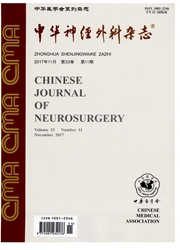

 中文摘要:
中文摘要:
目的评价应用血流导向装置治疗颅内动脉瘤的有效性和安全性。方法检索2008年1月至2016年12月PubMed、EBSCO以及WebofScience有关血流导向装置的文献,由2名评价员独立筛选、评价文献并提取资料,采用Stata软件进行统计学分析,以评估应用血流导向装置的有效性和安全性。结果53篇文献被纳入分析,包括4458例患者,共计4973个动脉瘤。在末次随访时,动脉瘤总体的完全闭塞率为79%(95%CI:75%~82%);血流导向装置输送到位并成功释放的手术成功率为97%(95%C1:95%-99%)。总体致死率为2%(95%CI:2%~3%),致残率为3%(95%CI:3%-4%)。治疗后出血性卒中、动脉瘤破裂出血、脑实质出血及缺血性卒中的发生率分别为2%(95%CI:1%~3%)、1%(95%C,:0%~1%)、1%(95%CI:1%~1%)以及4%(95%CI:3%~5%)。随访时支架内狭窄和载瘤动脉闭塞的发生率分别为5%(95%C1:3%~7%)和2%(95%CI:1%~4%)。对不同亚组的致死、致残率的分析显示,Silk血流导向装置组的致死、致残率(12%,95%CI:9%~15%)高于Pipeline血流导向装置组(4%,95%CI:3%-6%)和Surpass血流导向装置组(7%,95%CI:1%~17%)。大型和巨大型动脉瘤组的致死、致残率高于总体。结论Meta分析结果显示,血流导向装置治疗颅内动脉瘤有较高的完全闭塞率,其治疗总体安全,但并发症不可忽视。
 英文摘要:
英文摘要:
Objective To evaluate the efficacy and safety of flow diverters (FDs) used for intracranial aneurysms. Methods A systematic search was conducted in PubMed, EBSCO and Web of Science for all accessible articles on FDs between January 2008 and December 2016. Two authors independently graded the quality of the studies and extracted the data. Meta-analysis was performed using the software of Stata. Results Fifty-three articles containing 4 458 patients with 4 973 aneurysms were included in the analysis. The overall rate of complete occlusion was 79% (95% CI: 75% -82% ). The success rate of FD implantation was 97% (95% CI: 95% -99% ). Overall mortality and morbidity were 2% (95% CI: 2% - 3%) and 3% (95% CI: 3% - 4%), respectively. The rate of iutracranial hemorrhage, aneurysm rupture, intraparenchymal hematoma and ischemic stroke were 2% (95% CI: 1% - 3%), 1% (95% CI: 0% - 1%), 1% (95% CI: 1% - 1%) and 4% (95% CI: 3% - 5%), respectively. Stenosis of parent artery occurred in 5% (95% C1: 3% -7% ) of the patients. The rate of parent artery occlusion was 2% (95% CI: 1% -4% ). Subgroup analysis showed that the rates of mortality and morbidity were higher in Silk group (12%, 95% CI: 9% - 15% ) than those in Pipeline (4%, 95% CI: 3% -6% )and Surpass group(7% , 95% CI: 1% -17% ). The rates of morbidity and mortality were higher for large or giant aneurysms. Conclusion FDs are suggested to be effective and relatively safe tools for treatment of intraeranial aneurysms and, however, the complications should not be neglected.
 同期刊论文项目
同期刊论文项目
 同项目期刊论文
同项目期刊论文
 期刊信息
期刊信息
